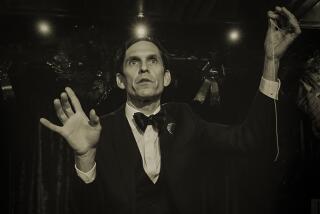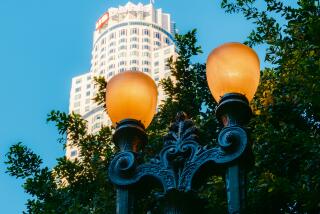The ‘magic’ lantern effect
- Share via
LONG before the birth of the motion picture, audiences worldwide were entertained by magic lantern shows that brought popular stories, temperance tales and ghosts and ghouls to vivid life.
Magic lanterns, the equivalent of today’s slide projectors, used fire instead of electric light to illuminate slides made of large pieces of glass that were painted with scenes from stories or printed with photographic images. And the basic form endured for centuries.
A program at the Academy of Motion Picture Arts and Science’s Linwood Dunn Theater will revisit the art as it appeared in Victorian England with “Magic Lanterns and the Evolution of Film Narrative,” a presentation of projections and illustrated entertainments by David Francis of the Library of Congress and Joss Marsh, professor of Victorian studies at Indiana University.
“The way we look at it, the lantern is just one phase in the screen experience which started with the camera obscura and went through the magic lantern to cinema and will continue after the cinema as we know it today has ended,” says Francis.
“But we feel the magic lantern has been neglected. When you consider it was running from 1659 up until the 1930s, the number of books written on the magic lantern shows compared to the first two decades of cinema is far less. What we are trying to do is not just to present lantern shows as entertainment, but to show the importance of the lantern slide shows as a presentation of novels.”
Back in 1659, the magic lantern was no more than a curiosity that could present crudely made slides. But it was novel, and, says Francis, “noblemen of that time loved to have soirees in which the latest technical invention was displayed. “At that time, no more than a dozen people could satisfactorily see the screen [at one time] because the light sources were very simple, like a candle. It would have been something you would have done in your library.”
The real heyday of the magic lantern shows, says Marsh, began in the 1780s with Etienne Gaspard Robertson’s Phantasmagoria shows. “They were absolutely extraordinary,” says Marsh. “They had multiple lanterns, some were hand-held, and they would be throwing images of corpses on the walls.”
The Phantasmagoria shows were accomplished through back projection using oils lamps as a light source inside the lanterns, which could be arrayed around the room.
“The Phantasmagoria [lantern] was on sort of a railway track, and if you pulled the lantern away from the screen the image grew bigger and if you went close to the screen, it grew smaller,” says Francis. “There was another lantern hidden in a coffin and a third lantern was strapped to the waist of one of the operators. He therefore could show images of all sorts of specters and ghosts all around the walls of the auditorium. It must have been a terrifying experience.”
Narratives became important in the magic lantern shows after the Great Exhibition of 1851 in London, where the first photographic slides were shown. Marsh says it is British novelist Charles Dickens whose works were most adapted for the format.
The lantern shows became more sophisticated after 1885, with companies making slides of professional actors performing scenes in front of painted backdrops. These photographic “life model” slides would then be hand-painted.
“Slides were expensive,” says Francis. “Even semi-professional lanternists could only have two or three series of slides. There was a lot of text for each slide.”
“They would string it out and make the most of each individual slide,” says Marsh.
Francis will be using an original 1891 lantern. “The only thing we can’t use is the original light source -- lime light, a mixture of oxygen and hydrogen, because health and safety regulations today wouldn’t allow you to use that within the auditorium. Everything else is original -- the lens, slides....”
“And we’re so old,” quips Marsh, “we’re nearly original.”
*
‘Magic Lanterns’
Where: Linwood Dunn Theater, 1313 N. Vine St., Hollywood
When: Thursday, 7:30 p.m.
Price: $5 for general public;
$3 for members and students with I.D.
Contact: 310-247-3000 or go to www.oscars.org
More to Read
The biggest entertainment stories
Get our big stories about Hollywood, film, television, music, arts, culture and more right in your inbox as soon as they publish.
You may occasionally receive promotional content from the Los Angeles Times.











